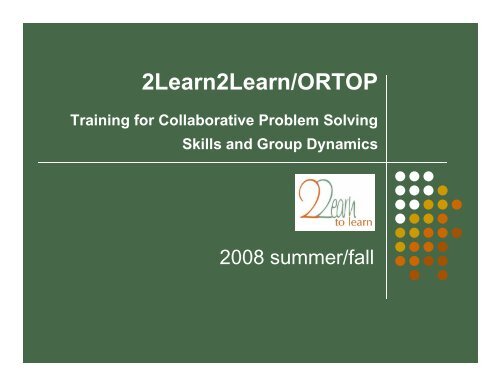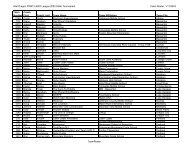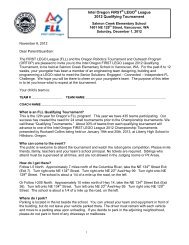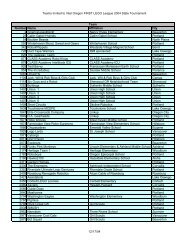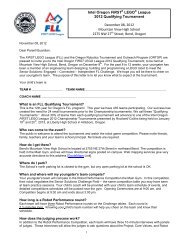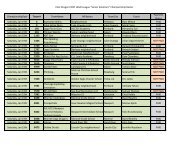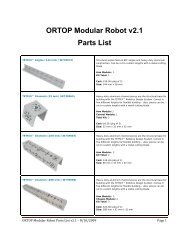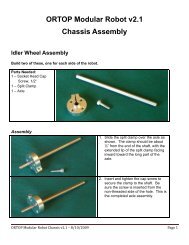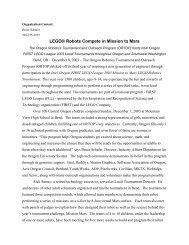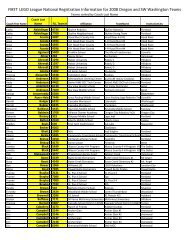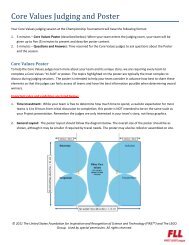"From Storming to Performing" PowerPoint Slide Presentation
"From Storming to Performing" PowerPoint Slide Presentation
"From Storming to Performing" PowerPoint Slide Presentation
Create successful ePaper yourself
Turn your PDF publications into a flip-book with our unique Google optimized e-Paper software.
2Learn2Learn/ORTOP<br />
Training for Collaborative Problem Solving<br />
Skills and Group Dynamics<br />
2008 summer/fall
Agenda<br />
• Our Premise<br />
• Four Stages of Small Group’s Life<br />
• Creative Exercise <strong>to</strong> move through Stages<br />
1-2<br />
• Two Problem-Solving Skills <strong>to</strong> teach kids for<br />
stages 2-4<br />
• Your Questions, Group Introductions
Four Stages of Group Life: Forming,<br />
<strong>S<strong>to</strong>rming</strong>, Norm’ing, Performing<br />
• Forming and <strong>S<strong>to</strong>rming</strong> are testing period of<br />
groups: struggle for status must be<br />
resolved or on-going struggles will disrupt<br />
task<br />
• Normal despair of coaches: My group will<br />
never overcome its dysfunction or struggles!!<br />
• Norm’ing and Performing: team gels and<br />
excels
The Task realm and the Social realm<br />
• Every team has a Social Realm AND a Task Realm:<br />
• Task Realm: programming and building robots.<br />
• Social Realm: attitudes <strong>to</strong>ward individuals and the group.<br />
• Adolescents construct status by binary ideas: “cool/nerd,”<br />
“good/poser,” “smart/stupid,” etc.<br />
• Status struggles have <strong>to</strong> do with the Social Realm, and fans the<br />
“<strong>S<strong>to</strong>rming</strong>” Stage<br />
• Coaches tend <strong>to</strong> over-manage the task realm, and be “hands-off”<br />
on the social realm; REVERSE EMPHASIS is needed.
Status Struggles: Ignore at Your Peril!<br />
• Status is based on “performance” deemed valuable<br />
by the peer group. . .<br />
• . . .from programming g <strong>to</strong> Ipod playlists<br />
• Coaches can assign jobs, but the group confers status<br />
• Status is slow <strong>to</strong> change, once established.<br />
• Low status kids can resent high-status kids, and may drop<br />
or be pushed from the group.<br />
• Limited resources of Robotics compounds status<br />
struggle<br />
• few lap<strong>to</strong>ps, single medium of Lego’s
Solution<br />
1. Coach expands activities in which one can<br />
perform impressively and gain status<br />
2. Coach identifies positive skills and traits<br />
observed in each kid, creating a “list”<br />
• Coach vocalizes and kids hear this list constantly<br />
• Kids may assimilate this “list” and incorporate<br />
in<strong>to</strong> their status system.
Creative Exercise: Why and How<br />
• Why: Generate a “list” of individuals’ skills,<br />
personality strengths that may help distribute<br />
status<br />
• What: Set up a non-Lego, complex creative group<br />
task, that enables the coach <strong>to</strong> observe and make<br />
notes about individual aptitudes, behaviors, skills.<br />
• When: ASAP!<br />
• How: Be a quiet, keen observer during the<br />
exercise, taking notes. Do not intervene. Allow<br />
kids’ skill-sets <strong>to</strong> become apparent.
Creative Exercise Outcomes<br />
At conclusion of creative production, coach names and affirms<br />
unique intellectual and social skills possessed by<br />
individuals (“You’re a detail person!”)<br />
• Coach presents affirmations/list, and gets more input from team:<br />
Writes on a large board<br />
• Coach shows a second list of possible jobs for team members,<br />
asks for team input on job descriptions, asks individuals <strong>to</strong><br />
choose . . .<br />
• job that t relates <strong>to</strong> their skill-set<br />
• Place jobs and skill ”list” on team website <strong>to</strong> record/reinforce<br />
• What other creative exercises could work?<br />
• Desired: non-Lego, an outcome that matters (has <strong>to</strong> be eaten, worn,<br />
lived in, etc)<br />
• Non-desired: limited range of skills needed, activities kids already<br />
have mastered, “loaded” with negative issues
Possible Group Jobs<br />
• Meeting Manager: runs<br />
meeting, works for<br />
inclusion of all voices<br />
• Webmaster: records<br />
decisions, on-going<br />
g<br />
problems; posts <strong>to</strong> team<br />
website<br />
• Stuff Manager: meeting<br />
time-keeper, schedules<br />
tasks and plans resources<br />
(team errands, car-<br />
pooling, snacks, etc) • Design Manager: stylemaster<br />
for all non-robotic<br />
• Scaffolder: divides and<br />
delegates egates robot problems<br />
(“divide and conquer”);<br />
summarizes what has<br />
been tried/solved, what’s<br />
next <strong>to</strong> try.<br />
• Research Manager:<br />
directs all research and<br />
discovers research<br />
resources and field visit<br />
sites<br />
creations, such as display<br />
boards, t-shirts, reports
Last Stages: social predictability<br />
gives rise <strong>to</strong> collaborative creativity<br />
• Norm'ing stage: Status issues resolved, kids<br />
understand and rely on each other<br />
• Individuals adjust their behavior <strong>to</strong> each other.<br />
• Team develops fluid work habits, generates rules,<br />
commitments and accountability, etc.<br />
• Feedback begins <strong>to</strong> flow easily, non-defensively.<br />
• Performing stage: high group loyalty<br />
• Intense task focus<br />
• Celebrations of group life<br />
• Sadness as group disbands
Behavior that fosters<br />
the Norm'ing Stage<br />
• Group abides by implicit and explicit social rules.<br />
• TAPPS and Scaffolding can serve as social rules<br />
• Coach/men<strong>to</strong>r should train team in TAPPS and<br />
Scaffolding asap.<br />
• Encourage team <strong>to</strong> devise its own rules of group life,<br />
g g p ,<br />
in addition <strong>to</strong> TAPPS and Scaffolding.
Thinking Aloud Pair Problem Solving
TAPPS works!<br />
• TAPPS improved speed of problem-solving (21%),<br />
application of learned skills <strong>to</strong> new situations (10%),<br />
and recognition of faulty hypotheses (20%).<br />
(Johnson and Chung, “The Effect of TAPPS on the Troubleshooting<br />
Ability of Aviation Technician Students”)<br />
• Nobel Laureate Carl Wieman leaves research <strong>to</strong> focus<br />
on science teaching that emphasizes pair problem-<br />
solving<br />
• TAPPS is “extreme programming,” the preferred<br />
method of work among many computer scientists.<br />
t
How <strong>to</strong> do TAPPS<br />
Problem Solver vocalizes every thought, including. . .<br />
• confusions<br />
• positive and negative “self-talk”<br />
• personal connections <strong>to</strong> the problem<br />
• visual approaches (draws on paper).<br />
Listener encourages constant vocalization, offers<br />
• encouragement<br />
• doesn’t impose his idea of a solution, but follows the PS’s ideas<br />
• counters negative self-talk<br />
• flags misunderstandings or errors (not, “That’s wrong!”)<br />
• if needed, suggests alternative ways of addressing problem<br />
Roles will be switched for optimum effect.
Scaffolding: Getting the Whole<br />
Team <strong>to</strong> Collaborate<br />
• Scaffolding is creating a structure for solving a<br />
complex problem<br />
• like a scaffold enables a worker <strong>to</strong> accomplish various<br />
tasks (scraping, spackling, painting, washing) in a complex<br />
“problem” of repair<br />
• Similar <strong>to</strong> FLL’s “divide and conquer”<br />
• The work of “dividing” is a specialized job, accomplished by<br />
a “superbright,” or More-Experienced Kid (ME)
Scaffolding: Your team’s roles<br />
1. The ME (More-Experienced Kid)<br />
• Acts as TAPPS PS, thinks through h complex problem<br />
out loud, preferably with paper and pencil<br />
• “Divides” : structures problem as set of distinct,<br />
individual problems<br />
• Delegates each distinct problem <strong>to</strong> each LE or<br />
TAPPS pair<br />
2. The LE (Less-Experienced Kid)<br />
• Solves his/her problem alone or in TAPPS pair<br />
Demo/role play for 3-4: The Robot Dance
Training your Team in TAPPS<br />
1. Demonstrate TAPPS with another adult ASAP, when<br />
introducing a new skill/problem <strong>to</strong> students.<br />
• Emphasize “This is the way we’ll problem-solve,<br />
as much as possible, because TAPPS works”<br />
2. Then, solve a second, related robotics problem, calling on<br />
one student <strong>to</strong> act as Problem-solver <strong>to</strong> your Listener<br />
3. Have entire team practice in pairs, using simple robotics<br />
problems or fun problems; feedback-discuss with team and<br />
provide rewards for good work and insights. i • Affirm and incorporate team’s nuancing of<br />
TAPPS<br />
4. Model TAPPS dialogue in all your interactions ti with<br />
students!
Training your Team in Scaffolding<br />
1. Introduce Scaffolding after TAPPS begins <strong>to</strong> take hold, and<br />
individual status is stabilizing (e.g. the group has settled on<br />
who is “expert” at Robotics)<br />
2. Explain “scaffolding,” as metaphor, possibly showing a<br />
funny scaffolding video from YouTube<br />
3. Help them implement their first scaffold, encouraging the<br />
leader <strong>to</strong> talk through problem out loud, seek feedback<br />
from team, write tasks down for all <strong>to</strong> see, delegate <strong>to</strong> all.<br />
4. Reward them when done!<br />
5. Repeat process ASAP, and gradually be more hands-off.
The Coach: Trainer and Artist<br />
• Trainer: Power of Repetition!<br />
• Rule of “21” – repeat, affirm, reward “the list” or<br />
any desired behavior 21 times/meetings<br />
• Artist: Alert and intuitive <strong>to</strong>. . .<br />
• Choosing the right word that captures a child’s<br />
special gifts and traits<br />
• Choosing the right moment <strong>to</strong> intervene <strong>to</strong><br />
teach/model TAPPS and Scaffolding


